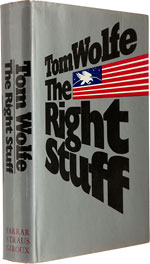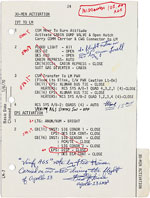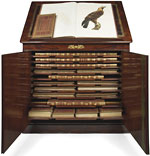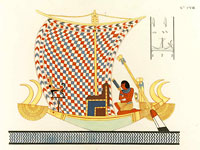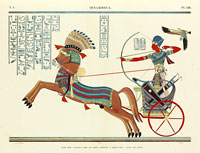 Ian McKay’s weekly column in Antiques Trade Gazette has been running for more than 30 years.
Ian McKay’s weekly column in Antiques Trade Gazette has been running for more than 30 years. Space Stuff
Tom Wolfe, The Right Stuff, $1,434 at Heritage of New York on April 8-9 and an Apollo XIII checklist, $111,020 at Bonhams New York on May 5.
A record bid on a 1979 first of Tom Wolfe’s account of the experimental road to manned space flight resulted from the fact that it was signed by Wolfe, by Chuck Yeager, the man who first broke the sound barrier in the Bell X-1, and by astronaut John Glenn, who in 1962 became the first American to orbit the earth.
Topping the bill at a Bonhams’ Space History sale was something very different, a heavily marked and annotated page from the checklists used on the aborted Apollo XIII mission. It relates to the steps required for the critical fifteen-second engine burn on the lunar module, Aquarius, that would enable the crew to survive the heating effects of re-entry to the earth’s atmosphere. The authenticity of the sheet is verified (and signed) by module pilot Fred Haise and mission commander James Lovell.
Egyptology on the Grand Scale
Description de l’Egypte, euros 1,095,400 ($1,561,930) at Christie’s Paris on May 11; plus Ippolito Rosellini, I Monumenti dell’egitto e della Nubia, £169,250 ($277,080) and J. F. Champollion, Monuments de l’Egypte et de la Nubie, £85,250 ($139,565) both at Sotheby’s London on May 10.
These three great works followed in the wake of Napoleon’s 1798 invasion of Egypt—an expedition that failed in its military aims but, through the work of the many scholars, scientists, archaeologists, etc. who had been attached to it, resulted in the rediscovery and initial excavations of the world of the ancient Egyptians.
Commissioned by Napoleon himself, the state sponsored Description of 1809-30 was at the time the largest printed work ever attempted. The combined work of many scholars and artists, co-ordinated by the Institut de l’Egypte, it was enormously influential in establishing Egyptology as an academic discipline and inspired a passion for Egyptian art and design across Europe.
The set sold in Paris was a large paper example in extremely fine condition, and one that had been presented by Charles X of France to his Minister of Justice, Jean-Joseph Courvoisier, who had the volumes sumptuously bound by Jean-Joseph Tissier of Paris in polished mahogany brown calf decorated in gilt and blind with tools of Egyptian inspiration.
This spectacular set, comprising nine folio text volumes, ten plate volumes, and another containing the preface and explanation of the plates in large folio format, plus three plate volumes in an even larger format, was housed in a specially designed cabinet made by Charles Morel.
Overall this set offered a total of 894 plates and maps, of which 42 are color printed and hand finished. Given that no copy of Description de l’Egypte had previously made much more than $175,000 at auction, the price is a truly exceptional one. It doubled the already bullish pre-sale estimate before being knocked down to an un-named US dealer.
Rosellini’s I Monumenti of 1832-44, running to nine octavo text volumes and three folio plate volumes, resulted from an 1828 expedition (jointly financed by the Grand Duke of Tuscany and Charles X of France) on which he was accompanied by his teacher and friend, Jean François Champollion. It runs to 194 engraved plates of which 139 are fully or partially colored.
The high price achieved by the Rosellini work reflects the fact that only one other example, and that lacking the text volumes and some of the plates, has been seen at auction in thirty-five years.
Champollion, of course, is the man who, with the Rosetta Stone as his key, first deciphered Egyptian hieroglyphs and really opened the door to Egyptian studies, and Monuments is his account of discoveries made in the Tuscan-Franco expedition he made with Rosellini.
Champollion died while the work was still in progress and though his brother oversaw the issue of the four folio plate volumes in the years 1835-45, the ten text volumes he had planned never appeared. With 507 plates, 51 of them colored, this set is the most complete to have been offered at auction in thirty-five years.
Uniformly bound in red half morocco gilt of the period, the two Sotheby’s lots [along with another set of the Description de l’Egypte that sold for £99,650 ($163,640)] came from the Royal College of Surgeons in Ireland, which is currently selling off travel, medical, and other books though Sotheby’s and other salerooms.








